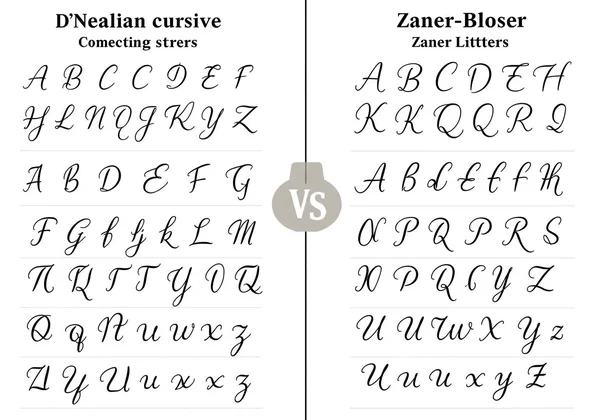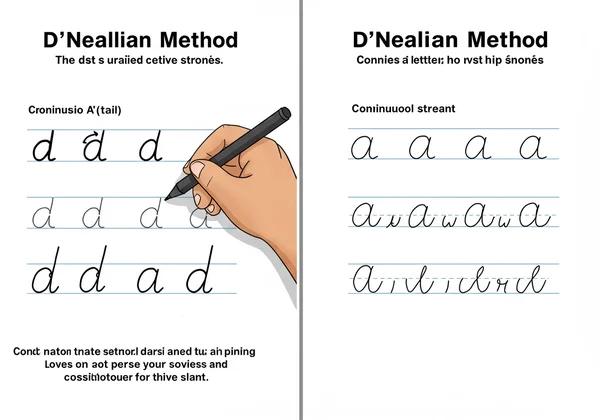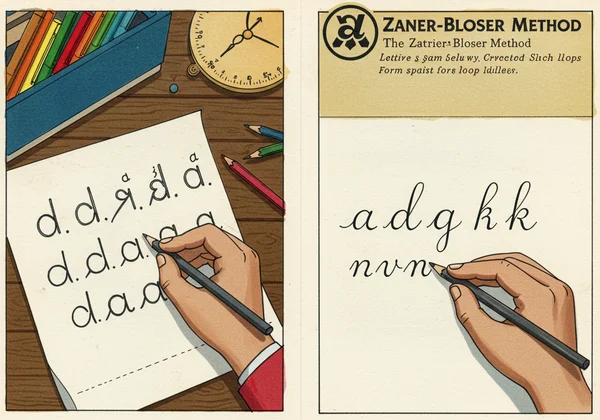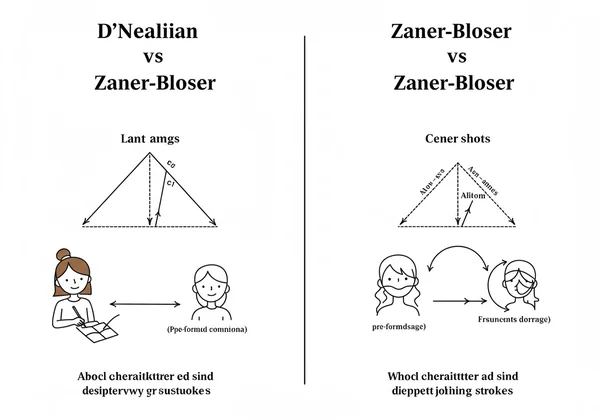Cursive Alphabet Styles: D'Nealian vs. Zaner-Bloser Guide
Starting your child's journey into the elegant world of handwriting can feel overwhelming, especially with different teaching methods available. As a parent or educator, you want to choose the best foundation for developing a legible and fluid script. This guide cuts through the confusion, helping you understand the two most prevalent cursive alphabet styles in the US: D'Nealian and Zaner-Bloser. If you've been asking yourself, what is the best way to start learning cursive, this detailed comparison will provide the clarity you need.
The choice between these two methods can significantly impact a child's learning experience. One emphasizes a gradual transition from print, while the other focuses on the distinct, classic forms of cursive letters. By exploring their unique features, benefits, and challenges, you'll be empowered to make an informed decision and find the perfect resources to support your young learner's journey. Let's begin exploring the right path for your child's beautiful handwriting with our free learning tools.

Understanding the D'Nealian Cursive Style
The D'Nealian method, introduced in the late 1970s, was designed to ease the transition from manuscript (print) to cursive writing. Its core philosophy is that children should not have to learn two entirely different systems for writing the alphabet. Instead, D'Nealian print letters have "tails" or connecting strokes that naturally evolve into their cursive counterparts. This creates a more seamless learning curve for young students.
This method is often favored in early elementary education for its intuitive approach. The consistency between the print and cursive forms helps reduce confusion and can build a student's confidence more quickly. The focus is on continuous strokes from the very beginning, preparing the hand and mind for the fluid connections essential to the full cursive writing alphabet.
What Defines D'Nealian Letterforms and Strokes?
The most defining feature of the D'Nealian letterforms and strokes is the slanted nature of both its manuscript and cursive letters. Unlike traditional block printing, D'Nealian manuscript letters are written at a slight slant, mirroring the angle of cursive. This consistency means students don't have to re-learn the angle of their letters when they move on to cursive.
Furthermore, many lowercase D'Nealian manuscript letters are formed with a continuous stroke that ends in an upward "tail." For example, the printed 'a' or 'd' concludes with a small flick that will later become the connecting stroke in cursive. This built-in feature makes linking letters a more natural progression rather than a new skill to be mastered.
Advantages and Disadvantages of D'Nealian for Young Learners
When considering D'Nealian for young learners, it's important to weigh its pros and cons. The primary advantage is the simplified transition from print to cursive, which can prevent frustration and make the learning process feel more cohesive. Many educators report that students grasp the connections between letters more easily with this method.
However, some critics argue that D'Nealian's manuscript style can be less clear and harder to read than traditional block print, potentially causing issues in early literacy. Additionally, because the letterforms are a hybrid, they are neither pure print nor pure traditional cursive. This might require more specific practice materials, but you can find a comprehensive A to Z cursive alphabet collection on our site to support this style.

Exploring the Zaner-Bloser Cursive Method
The Zaner-Bloser method is a more traditional approach to handwriting instruction that has been a staple in American schools for over a century. This method treats manuscript and cursive as two distinct, separate skills. Students first master vertical block printing, which is valued for its high legibility and simple, distinct letterforms. Only after achieving proficiency in print do they begin learning the more ornate and slanted forms of cursive.
The philosophy behind Zaner-Bloser is that mastering basic, legible printing first provides a strong foundation. The transition to cursive is then presented as a new and exciting step in their handwriting development. This clear separation can be beneficial for students who thrive on structured, step-by-step learning processes and a clear distinction between different skills.
Key Characteristics of Zaner-Bloser Cursive Alphabet
The key characteristics of the Zaner-Bloser cursive alphabet include its upright, circular letterforms and a more pronounced slant compared to D'Nealian. The letters are designed to be distinct and aesthetically pleasing, with clear starting and ending points. Unlike D'Nealian, the Zaner-Bloser manuscript letters are perfectly vertical and do not feature the pre-cursive "tails."
When students transition to cursive, they learn to add a slant and connect these letters with fluid loops and joining strokes. The capital letters in the Zaner-Bloser style are often more decorative and closely resemble traditional calligraphy cursive alphabet forms. This method emphasizes rhythm and uniformity in spacing and size, promoting a formal and elegant handwriting style. You can explore these letterforms with a printable cursive chart.
Benefits and Challenges of Zaner-Bloser Cursive Instruction
One of the main benefits of Zaner-Bloser is the high legibility of its initial manuscript printing, which can aid in early reading and writing development. The clear separation between print and cursive can also make instruction less confusing for some children. By mastering one system before moving to the next, students build a solid base of letter recognition.
The primary challenge lies in the transition itself. Because the cursive letterforms are fundamentally different from the print ones, some students may find it difficult to learn an entirely new way of writing the alphabet. This can feel like starting over and may require more intensive instruction and practice to master the connections and slant.

Side-by-Side Comparison: D'Nealian vs. Zaner-Bloser
Choosing between these two prominent cursive teaching styles often comes down to understanding their core differences in practice. While both aim to develop fluent handwriting, their paths to achieving that goal are distinct. The decision for your child or classroom will depend on which pedagogical approach aligns best with their learning style and your educational goals.
Let's break down the comparison into the most critical elements: how the letters connect, the slant of the script, and the overall ease of learning and legibility. This direct comparison will help illuminate which style might be a better fit. For hands-on practice, consider using a cursive alphabet worksheet designed for each style.
Analyzing Handwriting Connections and Slant
A key differentiator is found in handwriting connections and slant. D'Nealian is designed around connections from the start. Its slanted manuscript letters with exit strokes make the transition to linking letters smooth and intuitive. The slant is consistent between both print and cursive forms.
Zaner-Bloser, conversely, teaches vertical manuscript letters first. The concept of slant is introduced only when cursive instruction begins. The connections are taught as a separate skill, requiring students to lift their pencils less and learn to form flowing joins between letters that were previously written in isolation.
Legibility, Ease of Learning, and Pedagogical Approach
In terms of legibility and ease of learning, the debate continues. Supporters of D'Nealian argue its gradual approach is easier for children, reducing the cognitive load of learning two separate writing systems. However, the initial D'Nealian print can sometimes be less legible than the crisp, vertical Zaner-Bloser manuscript.
The Zaner-Bloser method's pedagogical approach is more compartmentalized. It prioritizes clear, readable print first, which strongly supports early reading. The subsequent move to cursive is treated as a new discipline. This structured method may appeal to methodical learners but can be a bigger hurdle for others.

Choosing the Right Cursive Teaching Style for Your Child
Ultimately, there is no single "best" method for every child. The right choice depends on the individual learner, the educational setting, and the goals of the instruction. Whether you're a teacher planning a curriculum cursive for schools or a parent supporting your child at home, considering these factors will lead you to the most effective path.
Your child's fine motor skills, learning temperament, and even the school's chosen curriculum can all play a role. The most important thing is to provide consistent support, encouragement, and high-quality practice materials. With the right approach, any child can master the art of beautiful cursive handwriting.
Factors to Consider for Home and School Environments
When making your decision, there are several factors to consider. If your child's school already uses a specific method, it's often best to align with it to avoid confusion. For homeschoolers or parents providing supplemental practice, consider your child's personality. Does your child prefer gradual changes (D'Nealian) or do they enjoy tackling new, distinct challenges (Zaner-Bloser)?
Also, evaluate their current print handwriting. If their print is already neat and they are ready for a new skill, Zaner-Bloser could be an excellent choice. If they struggle with letter formation, the transitional nature of D'Nealian might provide a gentler learning curve. You can find excellent practice resources here.
Supporting Your Child's Cursive Writing Journey with Free Resources
No matter which style you choose, consistent practice is the key to success. Supporting your child's journey with engaging and accessible materials will make all the difference. Instead of relying solely on workbooks, leverage interactive online tools and free resources to make learning fun.
On Cursive Alphabet, we provide a vast library of free, high-quality cursive alphabet worksheets and interactive guides. You can start learning now with resources tailored to help master every letter from A to Z. Our platform makes it easy to print practice sheets or even use our Cursive Font Generator to create custom copywork.

The Path Ahead: Mastering Cursive Handwriting with Confidence
Choosing between D'Nealian and Zaner-Bloser is a significant first step in guiding a young writer. D'Nealian offers a seamless, integrated path from print to script, while Zaner-Bloser provides a structured, traditional approach that builds upon distinct skills. By understanding their core philosophies and characteristics, you can select the method that best fits your child's needs and learning style.
The most crucial element of this journey is not the style itself, but the encouragement and consistent practice you provide. The art of the cursive alphabet is a valuable skill that builds discipline, fine motor control, and a personal connection to the written word. We invite you to explore our website and discover a world of free tools, worksheets, and resources designed to make learning cursive an enjoyable and rewarding experience for everyone.
Common Questions About Cursive Alphabet Teaching Styles
What is the main difference between D'Nealian and Zaner-Bloser cursive?
The main difference lies in their approach to teaching print and cursive. D'Nealian uses a slanted manuscript with connecting "tails" to create a smooth transition to cursive. Zaner-Bloser teaches traditional, vertical block printing first and then introduces slanted cursive as a separate and distinct writing system.
Is one cursive style considered easier for children to learn?
This depends on the child. Many educators find D'Nealian easier for young learners because the transition from print to cursive is more gradual, which can reduce frustration. However, children who thrive on clear, structured rules may find the Zaner-Bloser method of mastering one skill before starting another more straightforward. The key is finding what helps an individual learn how to quickly learn cursive.
Can I find practice worksheets for D'Nealian and Zaner-Bloser styles?
Yes, you can! While some resources may focus on one style, comprehensive platforms offer materials for both. On Cursive Alphabet, we provide a wide variety of free cursive alphabet printable worksheets that cater to different learning needs, allowing you to find the perfect practice sheets regardless of the method you choose.
Which cursive style is more commonly taught in schools today?
Both styles are still widely used, but their popularity can vary by region and school district. Zaner-Bloser has a longer history as a traditional method, while D'Nealian gained significant traction in the latter half of the 20th century for its transitional approach. It's always a good idea to check with your local school district to see which curriculum they have adopted.